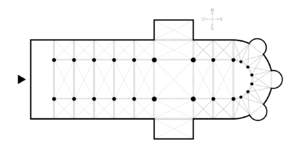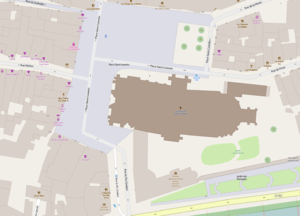Orientation of churches

Orientation of churches is the architectural feature by which the point of main interest in the interior, where the altar is placed, often within an apse, is towards the east (Latin: oriens). The main entrance is accordingly placed at the west end.
History
The first Christians faced east when praying, for which various explanations have been offered. In a tradition well established by the time of Christ, Jews in the diaspora would pray facing Jerusalem, which in most of the Roman Empire would have been to the East. Another explanation is that Christ's Second Coming would be on the clouds coming from the East: "For as the lightning cometh out of the east, and shineth even unto the west; so shall also the coming of the Son of man be." (Matthew 24:27). Due to this eastward posture of prayer, Tertullian (c. 160 — c. 220) says that some non-Christians thought they worshipped the sun.[1] Origen (c. 185 — 253) says: "The fact that [...] of all the quarters of the heavens, the east is the only direction we turn to when we pour out prayer, the reasons for this, I think, are not easily discovered by anyone."[2] Later on, various Fathers of the Church advanced mystical reasons for the custom.
At first, the orientation of the building in which Christians met was unimportant, but after the legalization of the religion in the fourth century, customs developed in this regard.[3] These differed in East and West.
The Apostolic Constitutions, a work of eastern Christianity written between 375 and 380 AD, gave it as a rule that churches should have the sanctuary (with apse and sacristies) at the east end, to enable Christians to pray eastward in church as in private or in small groups. In the middle of the sanctuary was the altar, behind which was the bishop's throne, flanked by the seats of the presbyters, while the laity were on the opposite side. However, even in the East there were churches (for example, in Tyre) that had the entrance at the east end and the sanctuary at the west end. During the readings all looked towards the readers, the bishop and presbyters looking westward, the people eastward. The Apostolic Constitutions, like the other documents that speak of the custom of praying towards the east, do not indicate on which side of the altar the bishop stood for "the sacrifice".[4][5]
The earliest Christian churches in Rome were all built with the entrance to the east, like the Jewish temple in Jerusalem.[6] Only in the 8th or 9th century did Rome accept the orientation that had become obligatory in the Byzantine Empire and was also generally adopted in the Frankish Empire and elsewhere in northern Europe.[3][6][7] The original Constantinian Church of the Holy Sepulchre in Jerusalem also had the altar in the west end.[8][9]
The old Roman custom of having the altar at the west end and the entrance at the east was sometimes followed as late as the 11th century even in areas of northern Europe under Frankish rule, as seen in Petershausen (Constance), Bamberg Cathedral, Augsburg Cathedral, Regensburg Cathedral, and Hildesheim Cathedral.[10]
The importance attached to orientation of churches declined after the 15th century.[11] In his instructions on the building and arrangement of churches, Charles Borromeo, archbishop of Milan from 1560 to 1584, expressed a preference for having the apse point exactly east, but accepted that, where that is impractical, a church could be built even on a north-south axis, preferably with the façade at the southern end. He stated that the altar can also be at the west end, where "in accordance with the rite of the Church it is customary for Mass to be celebrated at the main altar by a priest facing the people".[12]
The medieval mendicant orders generally built their churches inside towns and had to fit them into the town plans, regardless of orientation. Later, in the Spanish and Portuguese colonial empires they made no attempt to observe orientation, as is seen in San Francisco de Asis Mission Church near Taos, New Mexico. Today too in the West orientation is little observed in building churches.
Inexactitude of orientation

Charles Borromeo stated that churches ought to be oriented exactly east, in line with the rising sun at the equinoxes, not at the solstices, but some churches seem to be oriented to sunrise on the feast day of their patron saint. Thus St. Stephen's Cathedral, Vienna is oriented in line with sunrise on St. Stephen's Day, 26 December, in Julian calendar 1137, when it began to be built. However, a survey of old English churches published in 2006 showed practically no relationship with the feast days of the saints to whom they are dedicated. The results also did not conform to a theory that compass readings could have caused the variants. Taken as a body, those churches can only be said to have been oriented approximately but not exactly to the geographical east.[13]
Another survey of a smaller number of English churches examined other possible alignments also and found that, if sunset as well as sunrise is taken into account, the saint's day hypothesis covered 43% of the cases considered, and that there was a significant correspondence also with sunrise on Easter morning of the year of foundation. The results provided no support for the compass readings hypothesis.[14]
Yet another study of English churches found that a significant proportion of churches that showed a considerable deviation from true east were constrained by neighbouring buildings in town and perhaps by site topography in rural areas.[15]
Similarly, a survey of a total of 32 medieval churches with reliable metadata in Lower Austria and northern Germany discovered only a few aligned in accordance with the saint's feast with no general trend; there was no evidence of the use of compasses; and there was a preferred alignment towards true east, with variations due to town and natural topography.[11]
A notable example of an (approximately) oriented church building that, to match the contours of its location and to avoid an area that was swampy at the time of its construction, bends slightly in the middle is Quimper Cathedral in Brittany.
See also
References
- ↑ Tertuliano, Apologeticus, 16.9–10; translation
- ↑ "quod ex omnibus coeli plagis ad solam orientis partem conversi orationem fundimus, non facile cuiquam puto ratione compertum" (Origenis in Numeros homiliae, Homilia V, 1; translation
- 1 2 The Oxford Dictionary of Christian Art and Architecture (2013 ISBN 978-0-19968027-6), p. 117
- ↑ Constitutiones Apostolorum II, 57}: Ὁ οἶκος ἕστω ἐπιμήκης, κατὰ ἀνατολὰς ἐπιτραμμένος, ἐξ ἑκατέρων τῶν μερῶν ἔχων τὰ παστοροφορεῖα πρὸς ἀνατολήν [... κείσθω δὲ μέσος ὁ τοῦ ἐπισκόπου θρόνος, παρ' ἑκατέρου δὲ αὐτοῦ καθεζέσθωσαν τὸ πρεσβυτέριον [...] εἰς τὸ ἕτερον μέρος οἱ λαΐκοὶ καθεζέσθωσαν [...] μετὰ δὲ ταῦτα γινέσθω ἡ θυσία, ἑστῶτος παντὸς τοῦ λαοῦ (translation)
- ↑ William E. Addis, A Catholic Dictionary (Aeterna Press 1961), article "Church: place of Christian assembly"
- 1 2 Helen Dietz, "The Eschatological Dimension of Church Architecture"
- ↑ Oxford Dictionary of the Christian Church (2005 ISBN 978-0-19280290-3), p. 525
- ↑ D. Fairchild Ruggles, On Location: Heritage Cities and Sites (Springer 2011 ISBN 978-1-46141108-6), p. 134
- ↑ Lawrence Cunningham, John Reich, Lois Fichner-Rathus, Culture and Values: A Survey of the Humanities, Volume 1 |(Cengage Learning 2013 ISBN 978-1-13395244-2), pp. 208–210
- ↑ Heinrich Otte, Handbuch der kirchlichen Kunst-Archäologie des deutschen Mittelalters (Leipzig 1868), p. 12
- 1 2 Patrick Arneitz, Andrea Draxler, Roman Rauch, Roman Leonhardt, "Orientation of churches by magnetic compasses?" in Geophysical Journal, Volume 198, Issue 1, p.1-7
- ↑ Carlo Borromeo, Instructiones fabricae et suppellectilis ecclesiasticae (Fondazione Memofonte onlus. Studio per l'elaborazione informatica delle fonti storico-artistiche), liber I, cap. X. De cappella maiori (pp. 18–19)
- ↑ Ian Hinton, "Churches face East, don't they?" in British Archaeology
- ↑ Jason R. Ali, Peter Cunich, "The orientation of churches: Some new evidence" in The Antiquaries Journal
- ↑ Peter G. Hoare and Caroline S. Sweet, "The orientation of early medieval churches in England" in Journal of Historical Geography 26, 2 (2000) 162–173